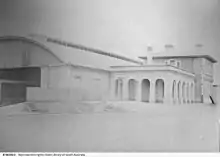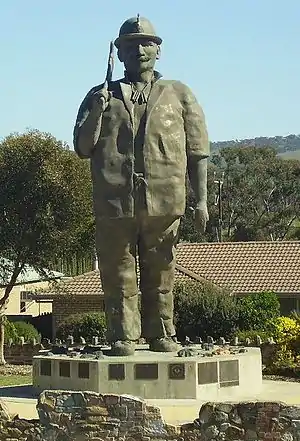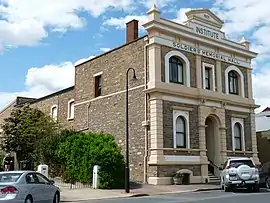Kapunda
Kapunda is a town on the Light River and near the Barossa Valley in South Australia. It was established after a discovery in 1842 of significant copper deposits. The population was 2,917 at the 2016 Australian Census.
| Kapunda South Australia | |||||||||||||||
|---|---|---|---|---|---|---|---|---|---|---|---|---|---|---|---|
 Looking towards the Baptist church | |||||||||||||||
 Kapunda | |||||||||||||||
| Coordinates | 34°20′20″S 138°55′00″E | ||||||||||||||
| Population | 2,917 (2016 census)[1] | ||||||||||||||
| Established | 1839 | ||||||||||||||
| Postcode(s) | 5373 | ||||||||||||||
| Elevation | 245 m (804 ft) | ||||||||||||||
| Location | 77 km (48 mi) north of Adelaide | ||||||||||||||
| LGA(s) | Light Regional Council | ||||||||||||||
| State electorate(s) | Stuart | ||||||||||||||
| Federal Division(s) | Barker | ||||||||||||||
| |||||||||||||||
| |||||||||||||||
The southern entrance to the town has been dominated since 1988 by the 8-metre (26 ft) statue of Map Kernow ("the son of Cornwall"), a traditional Cornish miner. The statue was destroyed by a fire in June 2006 but was rebuilt.
History
Francis Dutton and Charles Bagot, who both ran sheep in the area, discovered copper ore outcrops in 1842. They purchased 80 acres (32 ha) around the outcrop, beginning mining early in 1844 after good assay results. Mining began with the removal of surface ore and had progressed to underground mining by the end of the year.[2] Copper was mined until 1879. There are also quarries near the town which provide fine marble ranging from dark blue to white.[3] Marble from the Kapunda quarries was used to face Parliament House in Adelaide, and the pedestal of the statue of Venus on North Terrace, Adelaide is made of Sicilian and Kapunda marble.[4]
Ore was initially exported to Swansea, Wales, but later Welsh smelters migrated to South Australia and the ore was smelted locally by 1851.[5] Typically, the miners were Cornish, labourers were Irish and smelter specialists were Welsh. Trade and agriculture were Scottish and English. German farmers and timber cutters at nearby Bethel had already been in the area.[6] Underground mining became more difficult as the mines reached deeper. A steam engine to drive a water pump was installed in 1847, replaced by a larger one in 1851. Mining operations ground to a halt in 1851 with the impact of the Victorian gold rush, restarted in 1855.[7] In 1865, the mine was leased to a Scottish company which switched to open-cut mining methods and replaced the smelters with a different treatment method (cooking the ore with salt to produce copper chloride). Copper prices fell in 1877 and the mine closed in 1879.[8]

A railway from Adelaide was opened in 1860, and extended to Eudunda and Morgan in 1878.
The Corporate Town of Kapunda was established in 1865 to form a local governing body for the township and the District Council of Kapunda was established the following year to govern the surrounds.
The Baptist Church building was constructed in 1866.[9]
Kapunda is known for being the home of Sir Sidney Kidman ((1859–1935). He was a major cattle pastoralist who at one time owned 68 properties with a total area larger than the British Isles. He held annual horse sales at Kapunda with up to 3,000 horses sold during the week. His house, Eringa, was donated to the Education Department in 1921, and is still used as the administration building for the Kapunda High School.[10]
Kapunda was home to several notable manufacturers of farm and mining machinery: Robert Cameron, Joseph Mellors, James Rowe and Adamson Brothers.[11] It was with this last-named company that T. J. Richards, the founder of one of Australia's largest coach-building firms, started his career. H. B. Hawke and Co., began in 1857 and operated under various names.[12] The firm closed in 1983.
Kapunda had a strong Catholic community and Saint Mary MacKillop visited and established a convent there. St John's Reformatory for Girls operated from 1897 to 1909.[13] The second St Rose of Lima Catholic Church, replacing one designed by Edmund Wright and E. J. Woods built in 1866 and subsequently demolished, was built in 1938,[14] to designs by Herbert Jory in Romanesque Revival style, and has been described as "perhaps Jory's Romanesque masterpiece".[15] The Sydney-based magazine Builder commented that "the long narrow window openings, infilled with cast cement grilles, the design of which has an Eastern flavour, are an interesting innovation".[16]
Description

The southern entrance to the town has been dominated since 1988 by the 8-metre (26 ft) statue of Map Kernow ("the son of Cornwall"), a traditional Cornish miner. The statue was destroyed by a fire on the morning of 1 June 2006[17] but has since been rebuilt by its creator, Ben van Zetten.
Today, Kapunda is a producer of cereal crops, mainly wheat, barley and oats. Value-added services carried out by local industry include stock feed milling and hay processing. Kapunda is a contributor to the wine-growing industry centred in the nearby Barossa Valley.
The population was 2,917 at the 2016 Australian Census.[1]
The Kapunda Historical Society runs a museum housed in the old Baptist Church building.[9]
Kapunda has hosted the Kapunda Celtic Music Festival since 1976.
The town was titled the most haunted town in Australia after a television documentary went to air about this, which led to an increase in the number of tourists that visit the area. The ruins of the Reformatory, located outside the town, were bulldozed for this reason.
The town is close to the historic Anlaby Station with its 23-room homestead, houses, gardens and other buildings on the property, many of which are being restored by its current owners.[18]

Media
Kapunda was home to several newspapers. The Kapunda Herald (known as the Northern Star from 1860 to 1863 and the Kapunda Herald and Northern Intelligencer from 1864 to 1878) was printed in the town until 1951, when it was merged with the Barossa News to become the Barossa and Light Herald.
Another publication, the Farmers' Weekly Messenger (4 April 1874 – 27 September 1878) was also printed in Kapunda by Ebenezer Ward.[19] Within a month, in May 1874, it absorbed another Ward newspaper, Northern Guardian (1 April – 6 May 1874), which itself was a continuation of the Guardian and Northern and North-eastern Advertiser (19 May 1871 – 28 March 1874) and the short-lived Gumeracha Guardian and North-eastern Advertiser (19 March 1870 – 20 October 1870).
The North Kapunda Hotel was featured on television show Haunting: Australia, when cast member Allen Tiller, who was a local at the time, requested to producers, Flame Productions, that Kapunda, known as Australia's Most Haunted Town, should be a feature on the show. Haunting: Australia aired internationally in 2014.
Government
Kapunda is in the state electoral district of Stuart, the federal Division of Barker, and the centre of the Light Regional Council.
List of mayors
- Note This list currently ends in the 1950s due to the limitations of Trove.
- 1865–1866 Dr Matthew Henry Smyth-Blood (c. 1806 – 29 March 1883)[20]
- 1867–1868 James Pearce (1825 – 5 November 1904) donated his mayoral allowance to a "bounty fund"[21]
- 1869–1870 David Nock (c. 1829–1909)
- 1871 John Perry Moyle (c. 1826–1880)
- 1872–1874 Richard John Day ( –1916)[22]
- 1875–1876 J P Moyle*
- 1877 M H Smyth-Blood*
- 1878–1880 Joseph Rowett (c. 1825–1898)[23]
- 1881–1882 Robert Cameron (c. 1865–1893) founded Vulcan Iron works.[24]
- 1883–1885 John Fox Mellor (1841–1914) of Mellor Brothers, farm machinery makers.[25]
- 1886–1887 James Wheatley[lower-alpha 1] machinist[28]
- 1888–1889 David James
- 1890 Thomas David Nock (1850–1922) son of David Nock*
- 1891–1892 Alfred Palmer[29]
- 1893–1895 William Thomas, foundryworker and bookseller[30][31]
- 1896–1899 Evan James,[32] brother of David James*
- 1900 (resigned April) Henry Jackson (c. 1840–1912)[33]
- 1900–1905 David James* elected to SA Parliament May 1902
- 1906-1907 John Henry Hitchens[34]
- 1908–1911 Rees Rees[35][36]
- 1912–1914 Alfred Menhennett[37]
- 1915–1916 Samuel Ephraim Hancock[38]
- 1917–1918 Thomas Jeffs[39]
- 1919–1922 Herbert John Skull[40]
- 1923 Henry James Truscott[41]
- 1924–1927 Richard Hawke[42]
- 1928–1932 Thomas Samuel Davie[43]
- 1933–July 1936 William Thomas Truscott[44] (son of H J Truscott*)
- 1936–July 1942 Clair Hubert Branson (1886–1967) of Greenock, baker in Kapunda from 1917.
- 1942–July 1952 Horatio Hildabert Rees (son of mayor Rees Rees*)
- 1952 Leslie Noke Tilbrook[45]
- 1953– C H Branson*
- *Second entry for this person, see above
Notable people
- Ellen Ida Benham (1871–1917), educationist
- Vivian Bullwinkel (1915–2000), Australian Army nurse, P.O.W.
- Walter Dyer (1882–1965), New Zealand board member and chairperson of many education organisations; born in Kapunda[46]
- Albert Hawke (1900–1986), Premier of Western Australia
- Rosanne Hawke (born 1953), author
- Alice Rosman (1882–1961), writer
- Sidney Kidman (1859–1935), pastoralist
Gallery
.JPG.webp) View of the Anglican and Catholic churches from Gundry's Hill Lookout
View of the Anglican and Catholic churches from Gundry's Hill Lookout Institute and soldiers' memorial hall
Institute and soldiers' memorial hall The main open pit mine, now part of a museum site
The main open pit mine, now part of a museum site Vew of the Kapunda mine site looking east, with the chimney stack in the foreground.
Vew of the Kapunda mine site looking east, with the chimney stack in the foreground.
Notes
References
- , Australian Bureau of Statistics
- Drew, G. J. and Jones, J. (1988), p. 6
- Chisholm, Hugh, ed. (1911). . Encyclopædia Britannica. 15 (11th ed.). Cambridge University Press. p. 672.
- Venus, Statues of the City of Adelaide, Adelaide City Council.
- "Kapunda". Flinders Ranges Research. Retrieved 21 June 2017.
- "Kapunda". Australian Heritage. Retrieved 21 June 2017.
- "Kapunda". Cadia Valley Heritage. Newcrest Mining. Retrieved 22 June 2017.
- Atkinson, Amanda (29 March 2015). "Kapunda Mine Trail". Weekend Notes. Retrieved 22 June 2017.
- "Kapunda Museum". South Australian History Network. 29 August 2018. Retrieved 15 May 2019.
- History Kapunda High School. Retrieved 22 January 2021.
- "Agricultural Implement & General Machine Manufactories. Kapunda". South Australian Register. Adelaide. 18 July 1868. p. 4. Retrieved 17 December 2012 – via National Library of Australia.
- Charlton, Rob (1971). The History of Kapunda. South Australia: AUSTAPRINT. pp. 112–114. ISBN 0-85872-344-1.
- C. de Leiuen, Remembering the significant: St John's Kapunda, South Australia, Journal of the Australian Catholic Historical Society 36 (2015), 43-60.
- "Building Details: St Rose of Lima, Kapunda". Architects of South Australia. University of South Australia. Retrieved 19 January 2021.
- East, John W. (2016). Australian Romanesque: A History of Romanesque-Inspired Architecture in Australia. University of Queensland (Report). pp. 45, 159, 156. Retrieved 19 January 2021.
- "Roman Catholic Church, Kapunda". Builder. 6 (3): 13. 24 March 1941.
- "Map the Miner destroyed in fire". Australian Broadcasting Corporation. 1 June 2006. Archived from the original on 2 March 2008. Retrieved 6 June 2006.
- Trecassi, Louise. It may be insane but this beauty is worth the love. The Advertiser, 19 May 2006.
- The farmers' weekly messenger [newspaper: microform]. Kapunda, S. Aust: Ebenezer Ward. 1874.
- "Sudden Death of Dr Blood". Kapunda Herald. XIX (1537). South Australia. 30 March 1883. p. 3. Retrieved 13 November 2020 – via National Library of Australia.
- "Windfall for Workless". The Register News-pictorial. XCV (27, 839). South Australia. 5 November 1930. p. 4. Retrieved 13 November 2020 – via National Library of Australia.
- "Concerning People". The Register (Adelaide). LXXXI (21, 665). South Australia. 17 April 1916. p. 4. Retrieved 14 November 2020 – via National Library of Australia.
- "The Kapunda Herald". Kapunda Herald. XXXIV (2, 946). South Australia. 14 October 1898. p. 3. Retrieved 14 November 2020 – via National Library of Australia.
- "The Kapunda Herald". The Kapunda Herald. XXIX (2, 571). South Australia. 3 March 1893. p. 2. Retrieved 14 November 2020 – via National Library of Australia.
- "Personal". The Kapunda Herald. L (3, 749). South Australia. 10 April 1914. p. 2. Retrieved 14 November 2020 – via National Library of Australia.
- "Family Notices". South Australian Register. XXXV (7406). South Australia. 9 August 1870. p. 4. Retrieved 14 November 2020 – via National Library of Australia.
- "Family Notices". Kapunda Herald. XIV (1089). South Australia. 29 November 1878. p. 2. Retrieved 14 November 2020 – via National Library of Australia.
- McDougall & Vines (2004). "Heritage Survey of the Light Regional Survey" (PDF). Retrieved 15 November 2020.CS1 maint: uses authors parameter (link)
- "Personal". Evening Journal. XXXII (9081). South Australia. 18 January 1900. p. 2. Retrieved 14 November 2020 – via National Library of Australia.
- "The Mayor of Kapunda". The Evening Journal (Adelaide). XXVI (7247). South Australia. 6 January 1894. p. 5. Retrieved 12 November 2020 – via National Library of Australia.
- "Death of William Thomas J.P." The Kapunda Herald. XXXVI (3, 054). South Australia. 9 November 1900. p. 3. Retrieved 14 November 2020 – via National Library of Australia.
- "Mr Evan James". The Adelaide Observer. LII (2, 830). South Australia. 28 December 1895. p. 16. Retrieved 13 November 2020 – via National Library of Australia.
- "Death of Henry Jackson". The Kapunda Herald. XLVIII (3, 674). South Australia. 18 October 1912. p. 5. Retrieved 14 November 2020 – via National Library of Australia.
- "Death of Mr. J. H. Hitchens". Kapunda Herald. LXXV (5, 096). South Australia. 25 May 1939. p. 2. Retrieved 14 November 2020 – via National Library of Australia.
- "Personal". Kapunda Herald. XLVI (3, 581). South Australia. 16 December 1910. p. 5. Retrieved 31 October 2020 – via National Library of Australia.
- "Death of Kapunda Identity". The News (Adelaide). XXV (3, 767). South Australia. 17 August 1935. p. 7. Retrieved 14 November 2020 – via National Library of Australia.
- "Obituary". The Register (Adelaide). XCIII (27, 001). South Australia. 29 February 1928. p. 8. Retrieved 14 November 2020 – via National Library of Australia.
- "Death of S. E. Hancock, J.P." Kapunda Herald. LV (4, 075). South Australia. 20 August 1920. p. 2. Retrieved 14 November 2020 – via National Library of Australia.
- "Mr. T. Jeffs". Chronicle. LXXVII (40, 171). South Australia. 22 November 1934. p. 16. Retrieved 14 November 2020 – via National Library of Australia.
- "Concerning People". The Register (Adelaide). LXXXIV (22, 803). South Australia. 9 December 1919. p. 6. Retrieved 13 November 2020 – via National Library of Australia.
- "Death of H. J. Truscott". The Kapunda Herald. LXIX (4, 791). South Australia. 9 June 1933. p. 2. Retrieved 14 November 2020 – via National Library of Australia.
- "Death of Mr Richard Hawke". Kapunda Herald. LXXV (5, 108). South Australia. 17 August 1939. p. 2. Retrieved 14 November 2020 – via National Library of Australia.
- "Obituary". The Kapunda Herald. 80 (5, 357). South Australia. 22 June 1944. p. 2. Retrieved 14 November 2020 – via National Library of Australia.
- "Death of Mr. W. T. Truscott". The Kapunda Herald. 83 (5, 521). South Australia. 2 October 1947. p. 2. Retrieved 14 November 2020 – via National Library of Australia.
- "Mayor of Kapunda Dies". The Northern Argus. LXXXIII (5, 761). South Australia. 7 January 1953. p. 9. Retrieved 15 November 2020 – via National Library of Australia.
- Petersen, George Conrad (1961). Who's Who in New Zealand, 1961 (7th ed.). Wellington: A.H. & A.W. Reed. p. 118.
Further reading
- Drew, G. J.; Jones, J. (1988). Discovering historic Kapunda, South Australia. Adelaide: Department of Mines and Energy, Kapunda tourism committee. ISBN 0-7243-4277-X.
- Drew, G. J. (2017): Captain Bagot's Mine: Kapunda Mine, 1844–1916. Published by the author. ISBN 9780646969497
- Charlton, Rob (1971): The History of Kapunda Published by the District Council of Kapunda. ISBN 0-7256-0039-X
External links
![]() Media related to Kapunda, South Australia at Wikimedia Commons
Media related to Kapunda, South Australia at Wikimedia Commons